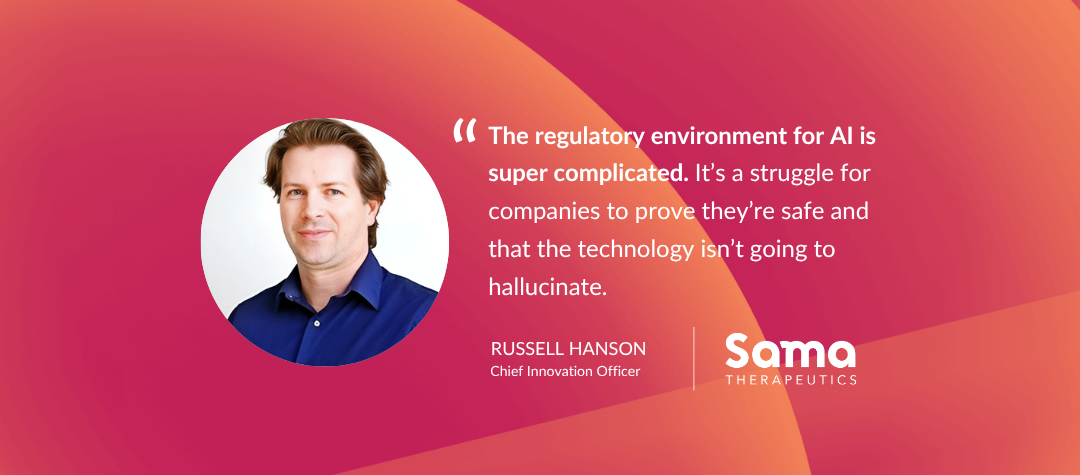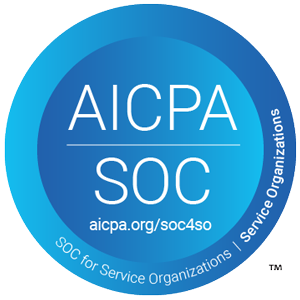Real-World Tactics for Leaders Looking to Turn Breakthrough Ideas into Scalable Impact
Disclaimer: The opinions represented here are those of the individual and do not necessarily represent those of their current or former employer.
Innovating in a complex business environment is no easy feat. It requires strategy, execution, and a focus on real-world impact to bring ideas to life. We spoke with Russell Hanson, Chief Innovation Officer of Sama Therapeutics, an AI-driven healthcare company, about what separates successful innovation initiatives from those that fizzle out. He shared how a practical mindset can help businesses succeed in a shifting landscape, and the ways leveraging AI is making it easier than ever for innovators to speed up their workflows.
Watch the full interview below, or read on for a selection of key takeaways.
Key takeaways:
- Prioritize solving real customer needs to ensure innovation efforts pay off. Innovations rooted in customer value are far more likely to succeed in the market
- Embrace emerging technologies to boost innovation speed and efficiency significantly. New tools (like AI assistants) can dramatically reduce the time and effort required from your team
- Integrate business strategy with technical innovation to bridge the lab-to-market gap successfully. Cross-functional planning and business acumen ensure great ideas can become profitable products, instead of gathering dust in the lab
- Foster a vibrant, collaborative innovation culture through hackathons and cross-functional teamwork. Engaging employees in creative sprints can spark breakthrough solutions and energize teams across your organization
- Invest in building internal talent and expertise instead of over-relying on outsourcing. Developing in-house capabilities retains critical knowledge and accelerates long-term innovation, whereas excessive outsourcing can drain expertise.
Focus Innovation on Customer Needs
Innovation efforts should start and end with the customer. No matter how cutting-edge a technology or idea is, it will stall if it doesn’t solve a real problem for customers or if there’s no market demand. Business history is littered with technically impressive projects that failed commercially because they didn’t address what the end-user truly cared about. As a leader, you should ensure your innovation teams are continually validating their ideas against customer needs and feedback. This might involve early user testing, market research, or even co-creating solutions with customers.
“Any company, any business, any organization is sort of beholden to their customers. If nobody’s using it, nobody cares. If nobody’s paying for it, it gets shelved… Whatever’s making money gets the attention. The customer is always right and we build stuff that our customers want. That’s just really important.”
Focusing on customer needs may seem like simple advice, but it’s a shockingly common area where businesses stumble. A CB Insights analysis of startup failures found that 42% failed because they were building something with no market need — by far the most common reason on the list. When kicking off a new project, start by writing a mock press release that emphasizes the benefits for the consumer. Framing the project that way helps you develop a clear vision for what you’re trying to accomplish in a practical, marketable way.
Embrace New Tech Tools to Amplify Productivity
Hanson points out that generative AI and coding assistants have matured to the point where they can dramatically speed up development cycles or data analysis, and as a leader, it’s important to keep an eye on these advancements and thoughtfully integrate them into your workflows. Studies have shown that adopting such tools can yield remarkable efficiency gains – for instance, AI coding assistants have been found to cut programming time by as much as 56% in some cases. In practice, this could translate to getting a prototype ready in days instead of weeks, or analyzing customer data in hours instead of days.
“It saves me a ton of time… to the point where I would have a PhD scientist from Yale doing the same thing as I have Claude (an AI) doing on a day-to-day basis. I’m able to transform a data file for my professor colleague at the University of Pennsylvania in 20 seconds, where it would have taken me half a day to do it. I just think it saves folks a lot of time. People who aren’t skilled in the art of vibe coding will probably have to learn how to program, but for those who do, it’s just a tool that’s safe.”
Shopify’s developers began using an AI coding assistant and saw their development cycles shorten and code reviews speed up; in one case, commit times dropped by about 15%, allowing features to roll out faster. These tools freed employees from repetitive tasks and enabled them to focus on creative, high-value projects. Don’t shy away from new technologies that can act as force multipliers. Pilot them on a small scale, gather results, and if they prove their worth (as many do), scale them up. By embedding the right tools, you empower your team to innovate faster and more efficiently than the competition.
Looking to put these principles into practice? Explore how Brightidea’s innovation management platform can help drive these changes in your organization.
Bridge the Gap Between Innovation and Business
Hanson is a firm believer that innovation executives should ensure that their teams aren’t innovating in a vacuum – technical teams need to collaborate with business strategists, finance, legal, and other functions early in the process. Bridging this gap might mean educating technical talent on business fundamentals, or pairing scientists and engineers with mentors in marketing and operations. Without this balance, even brilliant projects can stumble.
“They come from an engineering or science background and they don’t have a business background. Unfortunately, there are a lot of hurdles on the legal side, the business side, the tax side, the company formation side, and the capital raising side that are entire jobs. Coming straight out of school with a PhD and trying to learn business is a tough road. I think people learn that eventually. You kind of need an MBA to talk to the other MBAs, as we sometimes say… that’s what I’ve seen.”
To ensure innovations cross that proverbial chasm from prototype to product, leading companies build cross-functional teams and processes. A great example is Apple’s development of the first iPhone. Rather than handing off a concept from one silo to another, Apple formed a cross-disciplinary skunkworks team – hardware engineers, software developers, designers, and operations folks – all working closely together on “Project Purple.” In an interesting twist, one of the iPhone’s software engineers took on the role of spearheading its marketing strategy, even appearing in the first product demos. This blend of technical and business roles paid off enormously: despite some internal challenges, the iPhone’s launch was a massive success and the product became the cornerstone of Apple’s business.
Cultivate an Innovation Culture with Hackathons and Sprints
For innovation leaders, running hackathons or similar events can serve multiple purposes: they break down silos by bringing people from different departments together, energizing employees with a fun challenge. However, Hanson says it’s important to structure these events thoughtfully to get the most out of them. Hanson noted that simply declaring a hackathon in the office from 9-to-5 might not inspire the best results, but variety and a bit of spectacle will help. You might host it off-site, over a full day or two, or even virtually with participants from multiple locations. Providing some incentives (prizes, recognition) and executive support for follow-up can also ensure ideas don’t die on the vine once the event is over. When done right, hackathons can inject excitement into your innovation program and surface solutions that management didn’t even know employees were capable of.
“I almost wish we had more hackathons within our company. Getting people together – buying some pizzas or beers – and somehow accommodating folks with kids and families, since staying late at work isn’t appealing, is key. You could have a daytime or offsite hackathon, something more interesting than just going to your office and saying, ‘Today we’re going to have a hackathon.’ A little diversity, or just doing something different, would make the hackathon more fun and interesting.”
The value of hackathons and a collaborative innovation culture is evident in many organizations. Facebook is a prime example of harnessing hackathons for innovation. Facebook’s video uploading and sharing capability originated from a hackathon project when a pair of engineers pursued a passion to integrate video into the platform. Even Facebook’s Timeline profile design was born as a hackathon demo called “Memories,” which a small cross-functional team developed and presented; within a year, that concept evolved into the Timeline feature rolled out to all users. When employees see their hackathon ideas get real investment and turn into projects, it reinforces the message that innovation is everyone’s job. Over time, this kind of culture can be a true engine of growth and continuous improvement for your business.
Build Internal Capabilities and Limit Over-Outsourcing
While outsourcing certain tasks or projects can be useful, especially for speed or cost efficiency in the short term, outsourcing core innovation work can backfire badly. Hanson reflected on this from personal experience: relying too heavily on external vendors or contractors to build your product can lead to a loss of critical knowledge and skills within your organization. If an outside group develops the secret sauce of your business, you risk ending up empty-handed once their contract is over – you’ve essentially paid them to learn how to solve your problem, and you haven’t cultivated that expertise on your own team.
“I think one issue we had is we outsourced too much stuff. If I’d done less outsourcing and brought more people in – or better people in – instead of relying on outsourced work, that would have been better. If you pay an outside group to build your product, on one side, if they could build the product, they already would have, and you’re basically paying to train them to solve your problem. And then you lose the expertise of having your own person trained to solve your problem. Those are big problems with doing too much outsourcing.”
Plenty of companies have learned the value of developing internally versus excessive outsourcing. Tesla de-emphasized outsourced labor and vertically integrated its supply chain, which decreased its production costs by roughly 15% over a two-year span. Conversely, Boeing outsourced an unprecedented portion of design and manufacturing to external partners around the world, resulting in major delays and quality issues that have permanently sullied the brand’s reputation.
Innovate with Intention
Innovation doesn’t succeed in isolation. As Russell Hanson makes clear, moving from vision to real-world value requires strategic alignment, cultural momentum, smart technology adoption, and thoughtful execution. Whether you’re a C-level executive, innovation officer, or a VP leading change, embedding these principles into your workflow can make the difference between stalled efforts and sustainable breakthroughs.
To continue learning from top minds in innovation, connect with Russell Hanson on LinkedIn. His thought leadership in healthcare AI and digital transformation offers ongoing inspiration for innovation professionals across industries.
And if you’re ready to turn these ideas into action, explore how Brightidea can helpyour organization scale innovation with purpose. From hackathons to ideation pipelines to AI-enhanced decision-making, Brightidea empowers you to harness the full creative potential of your workforce and deliver measurable business results.


